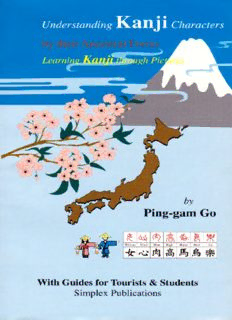Table Of ContentUnderstanding
Kanji Characters
by their Ancestral Forms
Learning JSffllJl through pictures
by
Ping-gam Go
Simplex Publications, San Francisco
Bythe sameAuthor:
. ReadChinese Today.
. What CharacterIs That? An Easy-AccessDictionary
of5,000 Chinese Characters.
Understanding Chinese Characters bytheirAncestralForms.
Understanding Kanji Characters by their Ancestral Forms.
© Gam
Copyright 2000 P. Go.
All rights reserved. No partofthis publication maybe reproduced, stored
inaretrieval systemortransmitted, in any formorbyanymeans, electronic,
mechanical, photocopying, recording, or otherwise, without the prior written
permissionofthePublisher.
ISBN: 0-9623113-6-7
PrintedintheU. S. A.
Contents
Introduction v-vi
Lesson A - Easy Kanji A1-A14
Review (Nos.1-4) A15-A20
Lesson B - Not So Easy Kanji B1-B29
Review I (with Ancestral Forms) B31-B34
Review II (without Ancestral Forms) B35-B43
Lesson C- Difficult Kanji C1-C2
Review (List ofDiff. Chars. Nos.1-4) C3-C6
Dictionary 0-1-47
Appendix Apd
Howto Write a Kanji Character and
Count the Number ofStrokes Howl-How3
List of Radicals Rad0-Radl-Rad22
A-G
Character Finder
in
IV
Qfitrofiuctiofi
There are two kinds ofKanji characters. Originally,
Kanji characters were pictures or combination ofpictures
from which one derived their meanings
Lessons A and B contain such characters. They are
called Tictograms n ( picto - picture; gram - writing).
Theywerewrittenwithastylus onbamboo orwood, orother
suitable material. Onlyathousand ortwo ofthem are known
today.
A Chinese general who had to write a report at the
end ofeach day, invented the writing brush. Writing with a
brush using ink and paper was much easier and faster than
writing with a stylus on bamboo or wood, etc.
However, thenew methodhad its drawbacks. Itled
to alterations ofthe originals, deviating more and more from
the original stylus writings, because the brush could not
make the loops and intricate drawings that the original stylus
written pictures contained.
Also, because the brush couldnot make adequate
drawings, new drawings were rarelycreated. Instead, a
new character was formed consisting oftwo existingpic-
tures. Onepicture showed to whichgroupofcharacters the
character belongs, andis calledthe "Radical " (radix =
root). The otherpicture showed the (Chinese)pronuncia-
tion ofthe character, andis calledthe "Phonetic" (phone
= sound). This new kind of characters are known as
"Phonograms" (phone = sound; gram = writing), as op-
posed to Tictograms" above. +yF
An example ofaPhonogram rf- Ocean [ Yang2]
consists ofthe Radical y (Water), which tells us that the
character belongs to the group ofcharacters that has some-
thingtodo with "Wdter". And the Phonetic }£L¥im2shows
the (Chinese) pronunciation ofthe character**
With Pictograms we can derive the meaning ot a
character from the picture or combination ofpictures
contained in the character. This is not possible with
Phonogramsasweseeabove. Wemust simplymemorize
the meaning ofa Phonogram!
This book contains 313 Kanji characters, which is about
one-third ofthe required number ofcharacters that an ele-
mentary school student in Japan should know. *
In order to leam above Kanji characters, we will study
them in three different lessons:
A
Lesson -EasyKanji. Inthis lesson, wewill study the
easy cases. Their meanings can be easily
derived from their ancestral forms.
Lesson B - Not So Easy Kanji. In this lesson, we will
study the cases that are not so easy to ex-
plain, even though we know theirancestral
forms.
Lesson C - Difficult Kanji. In this lesson, you will
find the cases that are difficult to explain,
namely the Phonograms.. There are no
ancestral forms from which you can derive
their meanings. You have to simply memo-
rize their meanings.
InJapan, 1,006Kanjicharactersaretaughtatthe Elementary School.
VI
Lesson
Easy Kanji
Abouthalf(40%) ofall Kanji characters in thisbook
can be learned easily, many ofthem very easily. There are
127 of such characters out of the total of 313 characters
discussed in this book.
At the end ofthis Lesson, there is a Review section in
which you can check your progress and determine which
charactersyouknow andwhichcharacters you donotknow.
You should study again the ones that you do not know.
Some charactersaredifficult, even thoughyou
knowtheir ancestral forms. In those cases, you can
followthetraditionalmethod,namelyby writingdown
those characters several times in a row, whilepro-
nouncingtheirmeanings. A chapter "HowtoWrite
a Kanji Cha^acte^,, appears intheAppendix.
Al
A2
p
The most simple Kanji characters are found in the Group
NUM—BERS . They are the characters for the n—umbers
ONE TWO JL andTHREE jr^ namely (one
=, = ,
stroke), (twostrokes) and (three strokes ). O
—
FOUR ^CJ was originallywritten Cp (a quantity
thatcan bedividedJ { into two equalportions). SIX jtt '
is another equal number; it was written <j\) , with a dot • Y7C7
to distinguishittornFOUR How about EIGHT /V?
'
That is anotherequal number ! Well, itwas written K ,
which means a quantity consistingof two equalhalves:
Pv
) and l^.
FIVE ^2Lwas considereda wi/f becausewehave oneach
ofourhands "five" fingers. It is still used as a unit in the
abacus, the old counting instrument The ancient writing for
X
"five" is .
SEVEN -^ was also considered a unit It was namely »\
a unit in fortune-telling. It was written as a unit with a ' '
"tail" *^ , to distinguish it from the unit "ten" -f~ .
TEN -4- weall know, is a unit in counting and written Jt
, p=
asasymmetric"cross", thesameas intheancientwriting -\- •
NINE J\j , beingalmost the unit "ten" <*fl , was writ- —
ten as "a wavyten"
.
MANY
The character for y? isrepresentedby twoobjects.
Here"object"is representedbythe symbol forMOUTH t? ,
a very simple symbol and easy to write.
^
AFEW, orALITTLE is whatisleftafteraportion *
J/*
SMALL
is taken away c^ fromsomething whatis already
J&>
i\'\(an object split into twoparts ) and \ )m
J { |
A3
Description:Ping-gam Go creates a complete lesson plan to learn Kanji characters by understanding the hidden art, myth, and culture within the characters of the written Japanese language. Lessons cover over 313 Japanese kanji characters, which is about one third of the required number of characters that an elem

